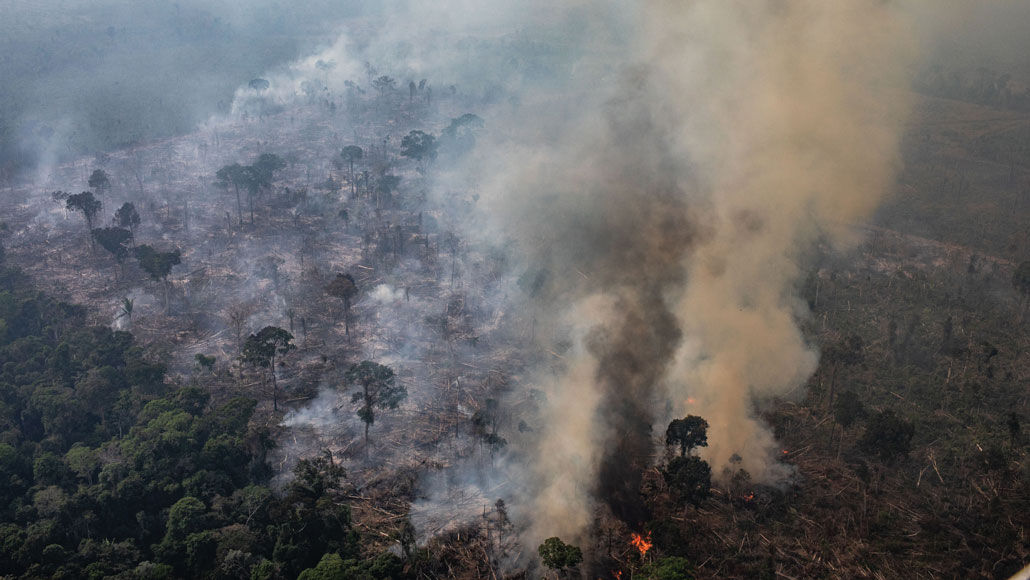A year of big numbers startled the world into talking about nature
Fires in the Amazon and the loss of billions of birds renewed worries about wildlife

A fire burns in Brazil’s Amazon region on August 25, 2019. This year, there was a surge in fires in the Amazon, one of Earth’s great biodiversity reservoirs.
Victor Moriyama/Getty Images
Some big numbers from nature made news in 2019. They were enough of a shock to get people talking about the dwindling diversity of plants, animals and other life on Earth, and what to do about it.
Some of that dramatic news came from the Amazon, where satellites picked up signs of a very active start to the annual fire season. The risk of a record-breaking season renewed worries about one of the richest reservoirs of biodiversity on Earth.
In August alone, satellite-based imaging instruments called MODIS logged 11,516 detections of fire in the large, northwestern Brazilian state of Amazonas. The number isn’t individual fires, but the number of pixels, each measuring at least a square kilometer, containing fire activity, explains Louis Giglio of the University of Maryland in College Park, a specialist in detecting fires with remote instruments. (Higher numbers reported by some news outlets tallied detections from an instrument with smaller pixels.)
As the fire season drew to a close in late October, Giglio worked out the big picture for the year. While fire risk in most of South America in 2019 was “very average,” Amazonas was “where chaos ensued,” he says. The fire detections for August exceeded all MODIS records for that month, which go back almost two decades, Giglio says. He ranks the 2019 fire season, from late June through October, as the second worst for Amazon burning, after the 2005 season.
The damage distresses Alexandre Aleixo of the University of Helsinki, who lived in the Amazon forest studying its birds for 16 years. He worries that the lure of land for farming in Brazil’s pro-development political climate is leading to land-clearing fires that easily jump into protected areas, threatening the biodiversity there.
Sign up for our newsletter
We summarize the week's scientific breakthroughs every Thursday.
Clearing jungles for soybeans or cattle is a good example of what a 2019 United Nations report called the main threat to nature: humans taking over wilderness for their own uses. That report made news by saying that around a million or so species of plants and animals globally — about 1 in 8 — face accelerated extinction unless damaged habitats are restored (SN: 6/8/19, p. 5). “Dead species walking” is one term used in the 1,500-plus-page draft of the report, released in an early form in May by the U.N.’s Intergovernmental Science-Policy Platform on Biodiversity and Ecosystem Services.
The real total of Earth’s imperiled species is probably larger than a million. The U.N. panel didn’t assess the abundant forms of fungi, which have given humans bread, wine and antibiotics, or the vast universe of nonfungal microbes. Even plant and animal numbers are estimates, of course; humans haven’t come anywhere close to giving names to all of Earth’s complex life.
The number 3 billion also startled people, prompting stories of the way things used to be. It’s the estimated total population drop in birds in the United States and Canada since 1970 (SN: 10/12/19 & 10/26/19, p. 7). Digging into decades of sightings of 529 species, including records from citizen scientists, researchers detected a growing bird deficit. Many rare birds known to be in peril have continued to decline, but unnervingly, even some common birds are dwindling. Pushy and adaptable starlings dropped 63 percent, for example. Today, overall, 29 percent fewer birds, the team estimates, are flying around in the United States and Canada than there were 50 years ago.
That loss “is a punch in the gut,” study coauthor Peter Marra of Georgetown University in Washington, D.C., told Science News when the research was released. It means fewer beaks to handle many ecosystem jobs, such as nabbing insects out of the air, spreading the pollen of deep-throated flowers or giving fruit seeds an intestinal ride to new homes.
Climate change is another of the U.N. report’s top five threats to biodiversity, and fighting it by planting trees to trap greenhouse gases sparked conversation this year. Ethiopia’s office of the prime minister tweeted that the nation planted more than 353 million tree seedlings on a Monday in July, declaring the feat a world record.
There’s room left on Earth to plant enough trees to trap an enormous amount of carbon, estimated ecologist Tom Crowther of ETH Zurich and colleagues in a high-profile and controversial paper published in the July 5 Science. It claimed that Earth has around 0.9 billion hectares suitable for planting more trees, enough in theory to capture some 205 metric gigatons of carbon (SN: 8/17/19, p. 4).
The paper brought “fresh attention” to the science behind the idea, says Alan Grainger, a global change geographer at the University of Leeds in England. But more than 70 scientists joined forces to call those numbers an overestimation on October 18, also in Science. The debate over how much carbon could be captured goes on (SN Online: 11/17/19). Yet Crowther argues that planting trees across just 10 percent of the area the original paper identified would be a worthy goal. Even better, his critics say, is to avoid emitting all those greenhouse gases in the first place.






